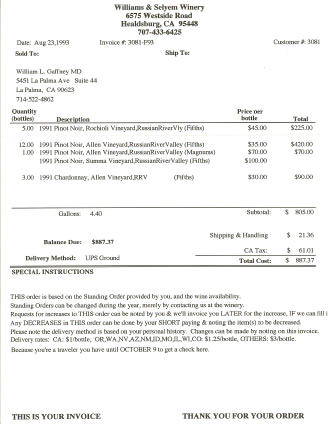Russian River Valley-Beaune in USA
Located sixty miles north of downtown San Francisco, the Russian River Valley is a
box-shaped region in northern Sonoma County just fifteen miles on any side. One
of thirteen appellations in Sonoma County, the four corners of the Russian River
Valley consist of the towns of Healdsburg and Guerneville in the north and Sebastopol
and Santa Rosa in the south. The Russian River Valley comprises 126,600
acres of rolling hills, dense red wood forests and apple orchards with 15,000 acres
planted to vineyards (depicted in green on the map below).
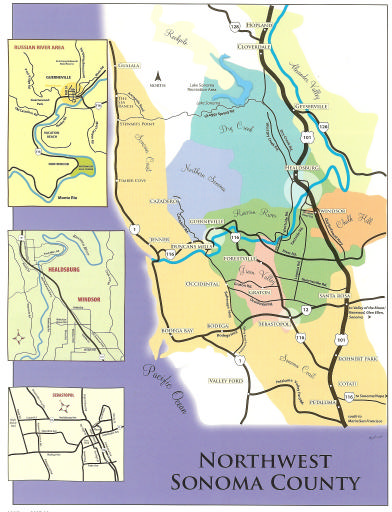
The Russian River Valley and River are named for Russian explorers who settled at Fort Ross, just north
of Jenner where the Russian River empties into the Pacific Ocean. According to Steve Heimoff, writing
in A Wine Journey Along the Russian River, the Russians landed on the Sonoma Coast at a site populated
by a Pomo Indian colony that the natives had named Metini. The Russians worked out a deal with the
Indians to settle at Metini and they named their new village Rossiya, after the name historically given
to their Russian homeland. It was years later before it became known as Fort Ross. The Pomo Indians
were the original inhabitants of the Sonoma Coast and the Russian River Valley and had named the
Russian River Shabakai or “long snake,” for its many twists and turns. The Russians adopted their own
name for the River, Slavianka or “pretty Russian girl.” By 1867, the Russians had left North America
entirely, leaving behind the anglicized names Russian River Valley and Russian River as their legacy.
The defining feature of the Russian River Valley is a single three-letter word: fog. Fog from the Pacific
Ocean is the most important single influence on viticulture here and it defines the boundaries of the
Russian River Valley appellation which was established in 1983. The fog enters the Valley during the
growing season from the southwest through the Petaluma Wind Gap between Pt Reyes and Bodega
Bay, with a smaller incursion traveling inward along the Russian River from its origins at Jenner on the
Sonoma Coast. Plenty of daytime warmth (the Russian River Valley is a Region III on the University of
California Davis scale) gives way to cool nights and mornings caused by the fog that pours in through
the Gap. The result is slowed ripening and extended hang time for the grapes. The winegrowers here
like to say that they turn fog into Pinot Noir.
There are many varietals that thrive in the diverse microclimates of the Russian River Valley. It was the
so-called “field blends” of varietals such as Grenache, Mourvèdre, Carignane, Petite Sirah, Syrah and
Alicante Bouschet along with Zinfandel that the Italian Americans grew so successfully and popularized
here. Some of these Italian-American immigrants’ families, such as Seghesio, Rochioli, Pedroncelli,
and Pellegrini, are still making wine in the Russian River Valley. With time, the region has become the
chosen one for growing the Burgundian varietals, Pinot Noir and Chardonnay.
The Russian River is 105 miles in length, beginning its journey in the coastal mountains in the north
near the town of Willits in Mendocino County, and winding south through the Alexander Valley before
reaching the Russian River Valley. Just below the town of Healdsburg, the River takes a turn to head
west toward the Pacific Ocean. The surrounding area here is the so-called Middle Reach of the Valley,
the sweet spot and birthplace of modern Pinot Noir viticulture in the Valley.
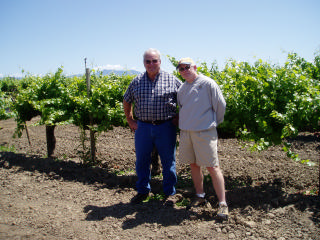
The first to plant Pinot Noir along Westside Road
in the Middle Reach was Steve and Helen
Bacigalupi in 1964 (Steve Heimoff notes that
Korbel has planted Pinot Noir as far back as the
1950s, but this was a few miles west where
Westside Road ends at River Road near Guerneville).
In 1968, shortly after his father passed
away, Joe Rochioli, Jr. (pictured right) in deference
to his father’s wishes planted Pinot Noir on
Westside Road along the banks of the Russian
River. This became the now infamous East
Block of Pinot Noir. West Block followed a year
later. In 1973, Davis Bynum, a San Francisco
Chronicle reporter, built the first winery on
Westside Road and he produced Pinot Noir from
Joe Rochioli Jr.’s first crop. The
1973 Davis Bynum Rochioli Vineyard Pinot Noir was the first Russian
River Valley vineyard-designated wine. The following year, Gary Farrell, who had majored in
political science at Sonoma State University, decided to become a winemaker and took a job at Davis Bynum. In 1982, Gary Farrell started his own label, Gary Farrell Wines, crafting Pinot Noir from
Rochioli grapes vinified at Davis Bynum. He continued as winemaker for Davis Bynum until 2000. Also
in 1982, Joe Rochioli Jr. and his son Tom started the Rochioli label. The first wines were made by
Farrell at Davis Bynum. By 1985, Tom had quit his job in the banking business and joined his father as
the winemaker. Early on Gary Farrell continued as a consultant and assisted in the planning and
construction of the Rochioli winery.
Gary Farrell would often hand-deliver his wines to customers in the Valley, one of whom was Ed
Selyem, who was the wine buyer for Speer’s Market in Forestville. In a
sfgate.com article dated
8/22/06 written by Linda Murphy, Gary Farrell was reported as saying, “Their (Ed Selyem and Burt
Williams) entry into the business caught me by surprise. Ed would ask me about the Rochioli vineyards,
about winemaking, and I gave him the recipe. It never occurred to me what he was up to until
Joe Rochioli told me that he’d sold grapes to Williams Selyem.”
The now legendary Williams Selyem Winery
was the original Russian River Valley garage
winery. Burt Williams hailed from Sebastopol,
worked as a proofreader for the San Francisco
Newspaper Agency (Chronicle and Examiner), and made wine at home. Ed
Selyem was a wine buyer and accountant for a small grocery store and crafted beer and fruit wine in his
garage in Forestville. Together they began
making wine from Sonoma Zinfandel grapes for
their own use in 1979. Their first commercial
winery was based in a rented garage on River
Road in Fulton beginning in 1984 (photo right
shows a recent photo of the garage).
The original name of their winery was Hacienda del Rio, a name Ed used on his first home-crafted
wines. The photo below left shows the 1980 Hacienda del Rio label. This wine was produced in Ed's
Forestville garage by Ed and Burt for friends and family and was not released commercially. The first
three commercial Pinot Noirs, 1981-1983, were made at Russian River Vineyards in Forestville, and bottled
under the Hacienda del Rio name. The wines were an instant success and Burgundy lovers began
to talk about the Williams Selyem Pinot Noir in revered tones. The Hacienda Del Rio label (below
right) looked exactly like the current Williams Selyem label, using the same letterpress lettering,
color and paper. A complaint from Hacienda Winery prompted the partners to drop the original name
and substitute their own beginning with the 1984 vintage.
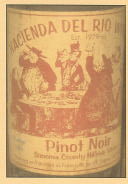
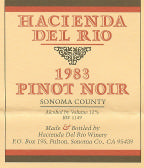
Williams was a burly vintner who had an uncanny and self-taught sense of how Pinot Noir should be
vinified. He never set foot in Burgundy. Production methods were old-fashioned to say the least,
prompted by the lack of capital. In the early years, Burt continued his job in San Francisco as did Ed at
Speer’s Market and they took vacations at crush time. They began with little money, never borrowed,
and grew 25% every year by starting small and plowing all of their income back into the business.
Wives Gayle Selyem and Jan Williams were also partners in the winery which early on hired no outside
help. It was a perfect business partnership as Burt was driven to make world-class wine and Ed
was determined to create a successful business from local agriculture. Burt preferred colorful sport
shirts with suspenders, Ed opted for t-shirts and boots. Both lived simply and shunned publicity.
There was never a sign at the garage announcing the winery’s location and there was no tasting room.

There were no great secrets to their success. They carefully chose their grape sources and did all of
the work in the winery themselves. Over time North American vintners have come to realize that Pinot
Noir requires delicate handling and constant vigilance in the winery, two things Ed and Burt practiced
from the start. Their winemaking methods were Old World (Burgundian if you will) primarily out of
necessity because they had little money to fund their operation. Their techniques were very labor intensive
and inefficient, but the result justified the effort. The Williams Selyem Pinot Noirs were
brimming with varietal character and although light in color, they had superb aromatic and flavor intensity.
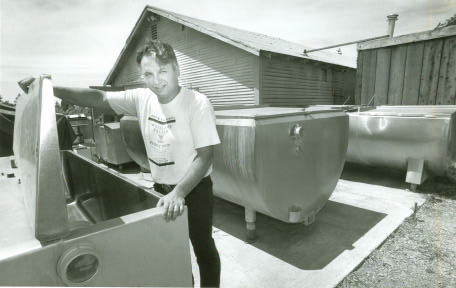
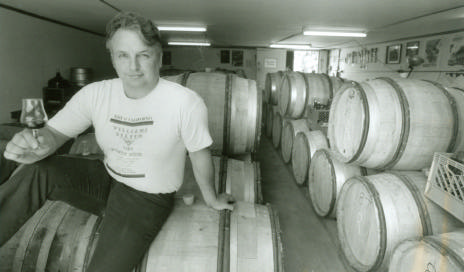
Denise Selyem, Ed’s daughter, recently was kind enough to share two photographs of Ed working at
the original winery in Fulton. The picture on top shows Ed outside the garage with the small, double walled,
stainless steel, recycled, open-top dairy tanks salvaged from a Windsor dairy farm in which
fermentations were carried out. The method of Pinot Noir production employed by Burt and Ed is now
currently practiced at least in some form by most California vintners of the Pinot Noir grape. Both Burt
and Ed constantly checked on the grapes in the vineyard. The grapes were picked ripe, put into
wooden crates and transported by pickup truck to the winery (see old photo on page 6) where they
were hand-sorted destemmed. Fermentations were long and cool. They got into the tanks and did some punch downs, but there was no crushing. The must was lightly pressed using a hand-operated
basket press dating from 1906. The wine was gravity-racked and the last gallons of juice were lifted
out of the tanks in buckets. The wine never saw a pump, a fining agent, or filtration. Aging was
carried out in mostly new French oak 225-liter barrels from Troncais made by Francois Freres. The
barrels were never used more than twice. The wine was hand-bottled, labeled and foiled.
The other photo on page 5 shows Ed inside one of the large shipping cargo containers which were
rigged to store barrels. The containers once held New Zealand lamb carcasses. Ed developed the
concept of a mailing list to distribute their wine long before mailing lists became the accepted way of
allocating scarce wine in California. Early on the wine was sold mainly to other winemakers and retailers
with good palates to whom the wine was often hand delivered.
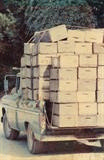
The more wine Williams Selyem made, the more favorable the press that followed, causing a snowball
effect in demand. The 1985 Williams Selyem Rochioli Vineyard Russian River Valley Pinot Noir
became the most seminal wine in the history of California Pinot Noir. This wine won the Sweepstakes at
the California State Fair Wine Competition, voted the best of the 2,136 wines entered by 416 California
wineries in 1987. 295 cases of the wine were produced and it sold for $16 a bottle! A copy of the original
newspaper article which appeared in the Santa Rosa Press Democrat is on page 7 which includes
the photo of Ed I obtained from Denise on page 5.
One of the keys to the success of Williams Selyem was that they were able to successfully contract with
the very best growers in the Russian River Valley. It was a simpler time and the growers were friendly
and unassuming folks that were easy to work with. All of Williams Selyem contracts were on a handshake
basis. Williams Selyem never did own any vineyards. Their now famous vineyard sources for
Pinot Noir included Rochioli Vineyard, Allen Vineyard, Cohn Vineyard, and Olivet Lane Vineyard in
the Russian River Valley, Summa Vineyard, Coastlands Vineyard, and Hirsch Vineyard on the Sonoma
Coast, and Ferrington Vineyard in Anderson Valley. In 1989, Howard Allen, owner of Allen Vineyard
which was located across Westside Road from Rochioli, built them a winery on his ranch which they
leased allowing them to move out of their rented garage in Fulton.
Williams Selyem Pinot Noir wine became so popular that a waiting list was developed for those
begging to get on the mailing list. Eventually 85% of their wine was sold directly to individuals on the
carefully guarded mailing list. Ed managed the list masterfully and enjoyed being in contact with,
visiting with, and learning from his devoted customers.

Williams Selyem produced credible Zinfandels (Ed and Burt thought initially that Zinfandel would be
their most successful wine) and Chardonnays, but it was the Pinot Noirs that drew most of the attention.
The Pinot Noirs were amazingly fruity and complex when young and seemed to age better than most
Pinot Noirs in California. The Pinot Noirs peaked around 6-7 years after release, but it was very difficult
to avoid drinking them young. The unlikely owners and the scarcity of their wine created a mystique,
but it was the wine’s quality and consistency that was the attraction. I was one of the fortunate
ones to be included on the mailing list beginning in 1991 (customer #3081) and the greatest California
Pinot Noir I have ever had was the
1992 Williams Selyem Rochioli Vineyard Russian River Valley
Pinot Noir. Alas, I learned recently that you can never go back. I purchased a bottle of this wine on
the secondary market as well as a bottle of the 1990 vintage. Now 15 and 17 years old respectively,
the wines showed brief flashes of their former brilliance upon opening, but quickly faded to ordinary
drink ability. A copy of my 1991 vintage offering from Williams Selyem is on page 9.
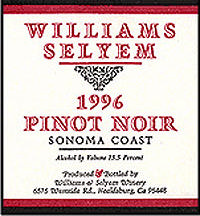
Wine writers of the 1990s spoke about Williams Selyem with superlatives
previously reserved for Burgundy such as, “Well-balanced, ripe
and juicy flavors, rich and supple texture, voluptuous and intensely
flavored, delicacy and finesse with profound flavor.” Dan Berger
raved, “Best Pinot Noir in America and a rival to the best in the world.”
Matt Kramer anointed Williams Selyem, “The Best Pinot Noir in California.”
Anthony Dias Blue chimed in, “Williams Selyem Pinot Noir shines
above the rest.” The customers were among the most devoted of any
winery I have experienced then and now. Chris Crevasse of Tennessee
wrote, “We are a little concerned about my brother-in-law, who had
never tried world-class wine until we shared a bottle of your 1991
Olivet Lane with him. Now he’s lost interest in work and has moved the
La-Z-Boy downstairs in the wine cellar. He claims he just wants to watch
but it’s hard to say what needs watching down there. We’re all hopeful that he’s just displaying the
initial zeal of a new convert, and that he will return to a more or less normal life when he gets accustomed
to venerating your wine.”
Win Wilson and Jack Daniels, the Napa Valley importers of Domaine de la Romanee-Conti came calling
to Williams Selyem in 1992. They wanted to compare wines. 22 wines and 5 hours later, no conclusions
were publicly reported, but the reason to do such a comparative tasting indicated the cache that
Williams Selyem had gained with the wine industry.
The popularity of their wines took their toil over the years on Ed and Burt. Managing the mailing list
and the hoards of wine enthusiasts trying to get on the list was a daunting task. Two of the seven fulltime
employees in the mid 1990s were designated as “keepers of the list.” Frank Prial, writing in The
New York Times (March 19, 1997), related a story about Ed Bradley, a correspondent on CBS’s “60 Minutes,”
and a wine enthusiast who wanted to get on the mailing list. Burt Williams said, “He told us that
if we didn’t put him on the list, he’d get Andy Rooney to do a commentary on people who keep lists.
Well, we couldn’t have that. So we put him on.” The partnership slowly developed some rife and Williams
Selyem was put on the market in 1997. It was eventually sold to John Dyson in 1998 for $9.5 million.
The official word was that Ed developed serious back problems from lifting wine cases over the
years, but the reasons had to be more complicated, yet were never divulged. The last vintage that Ed
and Burt vinified at Williams Selyem was 1997, with Burt consulting on the 1998 vintage. At the time the
winery was sold, there were 10,000 customers on the mailing list.
John Dyson, a wealthy New York politician, was a former New York state agriculture commissioner and
a former deputy mayor under Mayor Rudy Giuliani. He owns Millbrook Vineyards in upstate New York
and Villa Pillo Estate in Tuscany as well as Mistral and Vista Verde Vineyards on the central California
coast. He essentially paid a lot of money for the Williams Selyem name since Williams Selyem owned no vineyards or winery. In addition, he lost some hand-shake agreements such as the grapes from
Olivet Lane, Summa and Rochioli’s West Block. Several of the vineyard sources were retained.
Ed and Burt almost closed the winery for good before agreeing to sell Williams Selyem to Dyson, a
long time member of the mailing list. Upon purchasing the winery, Dyson hired the relatively unknown
Bob Cabral as his winemaker. Cabral (customer number 576 on the Williams Selyem list) was the son
of grape farmers who earned a degree in enology at Fresno State. He learned his trade at De Loach
Vineyards, Knude, Alderbrook and Hartford Court. Since assuming winemaking responsibilities,
Cabral has tried to follow Williams’ winemaking methods. After an inauspicious start (it is always difficult
to follow a legend), he is producing Pinot Noirs that are still eagerly sought after by the now 15,000
customers on the mailing list. The wines are a touch higher in alcohol, deeper in color, and offer more
fruit-driven flavors. As the winery now celebrates its 25th Anniversary with the release of the 2005 vintage,
the wines are carrying the flag with respectability and the single-vineyard designates continue to
be the stars.
Burt now splits his time between his ranch in the Anderson Valley and his fishing boat in Santa Barbara.
He grows Pinot Noir on his Morning Dew Vineyard and sells the grapes to his daughter at Brogan
Cellars and to Woodenhead and Whitcraft. When I asked him the inevitable question about making
his own Pinot Noir again after the non-compete agreement ends next year, he was noncommittal, but
said, “If I do decide to do it, I will devote all my energies seriously to the task. I will make small
amounts and it will cost a lot of money.” Ed has been spending his summers in Alaska and winters in
both California and Hawaii. His daughter, Denise Selyem and her husband Kirk Hubbard, craft Pinot
Noirs under the WesMar label, working in a small winery in Sebastopol reminiscent in size of the
original garage that Ed and Burt started with. Over the years, Williams Selyem became a training
ground for many other winemakers and a number of labels carry on the legacy including Papapapietro
Perry, Woodenhead, george, Cobb, and Anthill Cellars.
